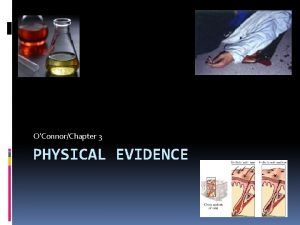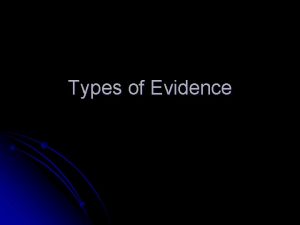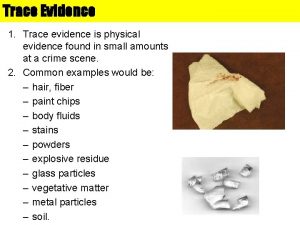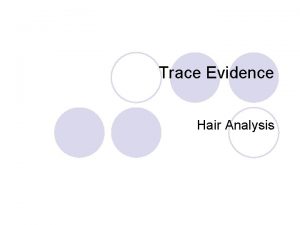OConnorChapter 3 PHYSICAL EVIDENCE Common types of physical












- Slides: 12

O’Connor/Chapter 3 PHYSICAL EVIDENCE

Common types of physical evidence Blood, semen, & saliva Documents Drugs Explosives Fibers Fingerprints Firearms & ammunition Glass Hair Impressions Organs & physiological fluids Paint Petroleum products Plastic bags Plastic, rubber, polymers Powder residues Serial numbers Soil & minerals Tool marks Vehicle lights Wood & other vegetative matter

The examination of physical evidence Identification- the process of determining a substance’s physical or chemical identity with as near absolute certainty as existing analytical techniques will permit.

Steps in Identification 1 st- requires the adoption of testing procedures that give characteristic results for specific standard materials. 2 nd- requires the number & type of tests needed to identify a substance be sufficient to exclude all other substances. Each type of evidence requires different tests and different degrees of specificity. Some can be proven with 1 test while others may take 6 tests to positively identify.

Comparison Is when you analyze a a specimen compared to a standard reference specimen, allowing you to determine commonalities, like origin. Example: paint chip on clothing of hit & run victim and paint from a car of a suspect.

The forensic comparison is actually a two-step procedure. 1 st- combinations of select properties are chosen from the suspect & the standard reference sample for comparison. (The overriding consideration must be the ultimate evidential value of the conclusion) 2 nd- after examination is completed, the forensic scientist must draw a conclusion about the origins of the specimens. (do they or do they not come from the same source)

Individual Characteristics Evidence that can be associated with a common source with an extremely high degree of probability has individual characteristics. Examples: Striations on bullets, fingerprints, wear on tires, footwear impressions, handwriting, separate pieces of a broken object that could be fit together, etc.

Proving Identity on Individual Characteristics It is not possible to state with mathematical exactness the probability that the specimens are of common origin; it can only be concluded that this probability is so high as to defy mathematical calculations or human comprehension. The experience of the examiner weighs in here: more experience=stronger reliability

Class Characteristics When evidence can be associated only with a group and never with a single source. This brings probability back into the picture- ex. car paint we can say the color, make, model and year of the car a paint chip came from- but not the actual car. If someone with motive, who was seen in the area in a car of that description is found the probability of guilt goes up.

Product Rule A formula for determining how frequently a certain combination of characteristics occurs in a population. The product rule states that one must first determine the probability of each characteristic occurring separately, then multiply together the frequencies of all independently occurring characteristics. The result is the overall frequency of occurrence for that particular combination of characteristics.

O. J. Simpson murder case: Bloodstain located at the crime scene was found to contain a number of factors that compared to his blood. Blood factors Frequency A 26% Es. D 85% PGM 2+2 - 2%

0. 26 x 0. 85 x 0. 02 = 0. 0044 Or . 44 percent, less than 1 in 200 people would be expected to have this particular combination of blood factors. (and this blood stain didn’t match either victim)
 Common types of physical evidence
Common types of physical evidence Slidetodoc.com
Slidetodoc.com Characteristics of physical evidence
Characteristics of physical evidence Primary evidence vs secondary evidence
Primary evidence vs secondary evidence Primary evidence vs secondary evidence
Primary evidence vs secondary evidence Primary evidence vs secondary evidence
Primary evidence vs secondary evidence Primary evidence vs secondary evidence
Primary evidence vs secondary evidence Jobs vancouver
Jobs vancouver Why is fiber considered class evidence
Why is fiber considered class evidence Class evidence vs individual evidence
Class evidence vs individual evidence Class evidence can have probative value
Class evidence can have probative value Class and individual evidence
Class and individual evidence Red herring fallacy
Red herring fallacy























